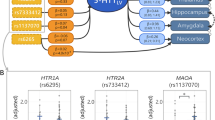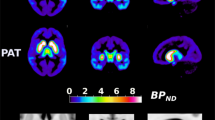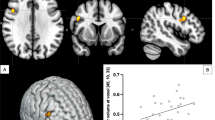Abstract
The dopamine (DA) and serotonin (5-HT) neurotransmission systems are of fundamental importance for normal brain function and serve as targets for treatment of major neuropsychiatric disorders. Despite central interest for these neurotransmission systems in psychiatry research, little is known about the regulation of receptor and transporter density levels. This lack of knowledge obscures interpretation of differences in protein availability reported in psychiatric patients. In this study, we used positron emission tomography (PET) in a twin design to estimate the relative contribution of genetic and environmental factors, respectively, on dopaminergic and serotonergic markers in the living human brain. Eleven monozygotic and 10 dizygotic healthy male twin pairs were examined with PET and [11C]raclopride binding to the D2- and D3-dopamine receptor and [11C]WAY100635 binding to the serotonin 5-HT1A receptor. Heritability, shared environmental effects and individual-specific non-shared effects were estimated for regional D2/3 and 5-HT1A receptor availability in projection areas. We found a major contribution of genetic factors (0.67) on individual variability in striatal D2/3 receptor binding and a major contribution of environmental factors (pairwise shared and unique individual; 0.70–0.75) on neocortical 5-HT1A receptor binding. Our findings indicate that individual variation in neuroreceptor availability in the adult brain is the end point of a nature–nurture interplay, and call for increased efforts to identify not only the genetic but also the environmental factors that influence neurotransmission in health and disease.
This is a preview of subscription content, access via your institution
Access options
Subscribe to this journal
Receive 12 print issues and online access
$259.00 per year
only $21.58 per issue
Buy this article
- Purchase on Springer Link
- Instant access to full article PDF
Prices may be subject to local taxes which are calculated during checkout



Similar content being viewed by others
References
Sawaguchi T, Goldman-Rakic PS . D1 dopamine receptors in prefrontal cortex: involvement in working memory. Science 1991; 251: 947–950.
Volkow ND, Gur RC, Wang GJ, Fowler JS, Moberg PJ, Ding YS et al. Association between decline in brain dopamine activity with age and cognitive and motor impairment in healthy individuals. Am J Psychiatry 1998; 155: 344–349.
Bäckman L, Ginovart N, Dixon RA, Wahlin TB, Wahlin A, Halldin C et al. Age-related cognitive deficits mediated by changes in the striatal dopamine system. Am J Psychiatry 2000; 157: 635–637.
Mehta MA, Manes FF, Magnolfi G, Sahakian BJ, Robbins TW . Impaired set-shifting and dissociable effects on tests of spatial working memory following the dopamine D2 receptor antagonist sulpiride in human volunteers. Psychopharmacology (Berl) 2004; 176: 331–342.
Lee B, Groman S, London ED, Jentsch JD . Dopamine D2/D3 receptors play a specific role in the reversal of a learned visual discrimination in monkeys. Neuropsychopharmacology 2007; 32: 2125–2134.
Reeves SJ, Mehta MA, Montgomery AJ, Amiras D, Egerton A, Howard RJ et al. Striatal dopamine (D2) receptor availability predicts socially desirable responding. Neuroimage 2007; 34: 1782–1789.
Cervenka S, Gustavsson JP, Halldin C, Farde L . Association between striatal and extrastriatal dopamine D2-receptor binding and social desirability. Neuroimage 2010; 50: 323–328.
Zald DH, Cowan RL, Riccardi P, Baldwin RM, Ansari MS, Li R et al. Midbrain dopamine receptor availability is inversely associated with novelty-seeking traits in humans. J Neurosci 2008; 28: 14372–14378.
Gjedde A, Kumakura Y, Cumming P, Linnet J, Møller A . Inverted-U-shaped correlation between dopamine receptor availability in striatum and sensation seeking. Proc Natl Acad Sci USA 2010; 107: 3870–3875.
Weiland BJ, Heitzeg MM, Zald D, Cummiford C, Love T, Zucker RA et al. Relationship between impulsivity, prefrontal anticipatory activation, and striatal dopamine release during rewarded task performance. Psychiatry Res 2014; 223: 244–252.
Jacobs BL, Azmitia EC . Structure and function of the brain serotonin system. Physiol Rev 1992; 72: 165–229.
Whitaker-Azmitia PM . Serotonin and brain development: role in human developmental diseases. Brain Res Bull 2001; 56: 479–485.
Savitz J, Lucki I, Drevets WC . 5-HT(1A) receptor function in major depressive disorder. Prog Neurobiol 2009; 88: 17–31.
Brunelin J, Fecteau S, Suaud-Chagny M-F . Abnormal striatal dopamine transmission in schizophrenia. Curr Med Chem 2013; 20: 397–404.
Howes OD, Kambeitz J, Kim E, Stahl D, Slifstein M, Abi-Dargham A et al. The nature of dopamine dysfunction in schizophrenia and what this means for treatment. Arch Gen Psychiatry 2012; 69: 776–786.
Kambeitz J, Abi-Dargham A, Kapur S, Howes OD . Alterations in cortical and extrastriatal subcortical dopamine function in schizophrenia: systematic review and meta-analysis of imaging studies. Br J Psychiatry 2014; 204: 420–429.
Volkow ND, Fowler JS, Wang GJ, Baler R, Telang F . Imaging dopamine’s role in drug abuse and addiction. Neuropharmacology 2009; 56: 3–8.
Volkow ND, Wang G-J, Fowler JS, Tomasi D, Telang F . Addiction: beyond dopamine reward circuitry. Proc Natl Acad Sci USA 2011; 108: 15037–15042.
Narendran R, Martinez D, Mason NS, Lopresti BJ, Himes ML, Chen C-M et al. Imaging of dopamine D2/3 agonist binding in cocaine dependence: a [11C]NPA positron emission tomography study. Synapse 2011; 65: 1344–1349.
Stokes PRA, Egerton A, Watson B, Reid A, Lappin J, Howes OD et al. History of cannabis use is not associated with alterations in striatal dopamine D2/D3 receptor availability. J Psychopharmacol 2012; 26: 144–149.
Volkow ND, Wang G-J, Telang F, Fowler JS, Alexoff D, Logan J et al. Decreased dopamine brain reactivity in marijuana abusers is associated with negative emotionality and addiction severity. Proc Natl Acad Sci USA 2014; 111: E3149–E3156.
Shrestha S, Hirvonen J, Hines CS, Henter ID, Svenningsson P, Pike VW et al. Serotonin-1A receptors in major depression quantified using PET: controversies, confounds, and recommendations. Neuroimage 2012; 59: 3243–3251.
Neale M, Cardon L . Methodology for genetic studies of twins and families. Kluwer Academic Publishers: Dordrecht, Boston, MA, USA, 1992.
Pinborg LH, Arfan H, Haugbol S, Kyvik KO, Hjelmborg JVB, Svarer C et al. The 5-HT2A receptor binding pattern in the human brain is strongly genetically determined. Neuroimage 2008; 40: 1175–1180.
Stokes PR a, Shotbolt P, Mehta M a, Turkheimer E, Benecke A, Copeland C et al. Nature or nurture? Determining the heritability of human striatal dopamine function: an [18F]-DOPA PET study. Neuropsychopharmacology 2013; 38: 485–491.
Lichtenstein P, De Faire U, Floderus B, Svartengren M, Svedberg P, Pedersen NL . The Swedish Twin Registry: a unique resource for clinical, epidemiological and genetic studies. J Intern Med 2002; 252: 184–205.
Spitzer RL, Williams JBW, Gibbon M . Structured Clinical Interview for DSM-III-R - Non Patient Version (SCID-NP). Biometrics Research Department, New York State Psychiatric Institute: : NY, USA, 1986.
Farde L, Hall H, Pauli S, Halldin C . Variability in D2-dopamine receptor density and affinity: a PET study with [11C]raclopride in man. Synapse 1995; 20: 200–208.
Borg J, Henningsson S, Saijo T, Inoue M, Bah J, Westberg L et al. Serotonin transporter genotype is associated with cognitive performance but not regional 5-HT1A receptor binding in humans. Int J Neuropsychopharmacol 2009; 12: 783–792.
Hirvonen J, van Erp TGM, Huttunen J, Aalto S, Någren K, Huttunen M et al. Increased caudate dopamine D2 receptor availability as a genetic marker for schizophrenia. Arch Gen Psychiatry 2005; 62: 371–378.
Hannelius U, Gherman L, Mäkelä V-V, Lindstedt A, Zucchelli M, Lagerberg C et al. Large-scale zygosity testing using single nucleotide polymorphisms. Twin Res Hum Genet 2007; 10: 604–625.
Wienhard K, Dahlbom M, Eriksson L, Michel C, Bruckbauer T, Pietrzyk U et al. The ECAT EXACT HR: performance of a new high resolution positron scanner. J Comput Assist Tomogr 18: 110–118.
Bergström M, Boëthius J, Eriksson L, Greitz T, Ribbe T, Widén L . Head fixation device for reproducible position alignment in transmission CT and positron emission tomography. J Comput Assist Tomogr 1981; 5: 136–141.
Langer O, Någren K, Dolle F, Lundkvist C, Sandell J, Swahn C-G et al. Precursor synthesis and radiolabelling of the dopamine D2 receptor ligand [11C]raclopride from [11C]methyl triflate. J Label Compd Radiopharm 1999; 42: 1183–1193.
Hall H, Lundkvist C, Halldin C, Farde L, Pike V, McCarron J et al. Autoradiographic localization of 5-HT1A receptors in the post-mortem human brain using [3H]WAY-100635 and [11C]WAY-100635. Brain Res 1997; 745: 96–108.
Schain M, Tóth M, Cselényi Z, Stenkrona P, Halldin C, Farde L et al. Quantification of serotonin transporter availability with [11C]MADAM—a comparison between the ECAT HRRT and HR systems. Neuroimage 2012; 60: 800–807.
Mawlawi O, Martinez D, Slifstein M, Broft A, Chatterjee R, Hwang DR et al. Imaging human mesolimbic dopamine transmission with positron emission tomography: I. Accuracy and precision of D(2) receptor parameter measurements in ventral striatum. J Cereb Blood Flow Metab 2001; 21: 1034–1057.
Martinez D, Slifstein M, Broft A, Mawlawi O, Hwang D-R, Huang Y et al. Imaging human mesolimbic dopamine transmission with positron emission tomography. Part II: amphetamine-induced dopamine release in the functional subdivisions of the striatum. J Cereb Blood Flow Metab 2003; 23: 285–300.
Roland PE, Zilles K . Brain atlases—a new research tool. Trends Neurosci 1994; 17: 458–467.
Lammertsma AA, Hume SP . Simplified reference tissue model for PET receptor studies. Neuroimage 1996; 4: 153–158.
Gunn RN, Sargent PA, Bench CJ, Rabiner EA, Osman S, Pike VW et al. Tracer kinetic modeling of the 5-HT1A receptor ligand [carbonyl-11C]WAY-100635 for PET. Neuroimage 1998; 8: 426–440.
Cselényi Z, Olsson H, Halldin C, Gulyás B, Farde L . A comparison of recent parametric neuroreceptor mapping approaches based on measurements with the high affinity PET radioligands [11C]FLB 457 and [11C]WAY 100635. Neuroimage 2006; 32: 1690–1708.
Boker S, Neale M, Maes H, Wilde M, Spiegel M, Brick T et al. OpenMx: an open source extended structural equation modeling framework. Psychometrika 2011; 76: 306–317.
Boker S, Neale M, Maes H, Wilde M, Spiegel M, Brick T et al. OpenMx 1.3 User Guide 2012; http://openmx.psyc.virginia.edu/docs/OpenMx/latest/OpenMxUserGuide.pdf (accessed on 8 August 2014).
Team RC. R: A language and environment for statistical computing. R Found. Stat. Comput. 2013; http://www.r-project.org/.
Rabiner E a, Messa C, Sargent PA, Husted-Kjaer K, Montgomery A, Lawrence AD et al. A database of [(11)C]WAY-100635 binding to 5-HT(1A) receptors in normal male volunteers: normative data and relationship to methodological, demographic, physiological, and behavioral variables. Neuroimage 2002; 15: 620–632.
Sullivan PF, Kendler KS, Neale MC . Schizophrenia as a complex trait: evidence from a meta-analysis of twin studies. Arch Gen Psychiatry 2003; 60: 1187–1192.
Faraone SV, Perlis RH, Doyle AE, Smoller JW, Goralnick JJ, Holmgren MA et al. Molecular genetics of attention-deficit/hyperactivity disorder. Biol Psychiatry 2005; 57: 1313–1323.
Lichtenstein P, Yip BH, Björk C, Pawitan Y, Cannon TD, Sullivan PF et al. Common genetic determinants of schizophrenia and bipolar disorder in Swedish families: a population-based study. Lancet 2009; 373: 234–239.
Chang Z, Lichtenstein P, Asherson PJ, Larsson H . Developmental twin study of attention problems: high heritabilities throughout development. JAMA Psychiatry 2013; 70: 311–318.
Kendler KS, Gatz M, Gardner CO, Pedersen NL . A Swedish national twin study of lifetime major depression. Am J Psychiatry 2006; 163: 109–114.
Jönsson EG, Nöthen MM, Grünhage F, Farde L, Nakashima Y, Propping P et al. Polymorphisms in the dopamine D2 receptor gene and their relationships to striatal dopamine receptor density of healthy volunteers. Mol Psychiatry 1999; 4: 290–296.
Pohjalainen T, Rinne JO, Någren K, Lehikoinen P, Anttila K, Syvälahti EK et al. The A1 allele of the human D2 dopamine receptor gene predicts low D2 receptor availability in healthy volunteers. Mol Psychiatry 1998; 3: 256–260.
Hirvonen MM, Lumme V, Hirvonen J, Pesonen U, Någren K, Vahlberg T et al. C957T polymorphism of the human dopamine D2 receptor gene predicts extrastriatal dopamine receptor availability in vivo. Prog Neuropsychopharmacol Biol Psychiatry 2009; 33: 630–636.
Willeit M, Praschak-Rieder N . Imaging the effects of genetic polymorphisms on radioligand binding in the living human brain: A review on genetic neuroreceptor imaging of monoaminergic systems in psychiatry. Neuroimage 2010; 53: 878–892.
Rilke O, May T, Oehler J, Wolffgramm J . Influences of housing conditions and ethanol intake on binding characteristics of D2, 5-HT1A, and benzodiazepine receptors of rats. Pharmacol Biochem Behav 1995; 52: 23–28.
King MV, Seeman P, Marsden CA, Fone KCF . Increased dopamine D2High receptors in rats reared in social isolation. Synapse 2009; 63: 476–483.
Fitzgerald ML, Mackie K, Pickel VM . The impact of adolescent social isolation on dopamine D2 and cannabinoid CB1 receptors in the adult rat prefrontal cortex. Neuroscience 2013; 235: 40–50.
Morgan D, Grant KA, Gage HD, Mach RH, Kaplan JR, Prioleau O et al. Social dominance in monkeys: dopamine D2 receptors and cocaine self-administration. Nat Neurosci 2002; 5: 169–174.
Hirvonen J, van Erp TGM, Huttunen J, Aalto S, Någren K, Huttunen M et al. Brain dopamine d1 receptors in twins discordant for schizophrenia. Am J Psychiatry 2006; 163: 1747–1753.
Ito H, Kodaka F, Takahashi H, Takano H, Arakawa R, Shimada H et al. Relation between presynaptic and postsynaptic dopaminergic functions measured by positron emission tomography: implication of dopaminergic tone. J Neurosci 2011; 31: 7886–7890.
Howes O, Bose S, Turkheimer F, Valli I, Egerton A, Stahl D et al. Progressive increase in striatal dopamine synthesis capacity as patients develop psychosis: a PET study. Mol Psychiatry 2011; 16: 885–886.
Shotbolt P, Stokes PR, Owens SF, Toulopoulou T, Picchioni MM, Bose SK et al. Striatal dopamine synthesis capacity in twins discordant for schizophrenia. Psychol Med 2011; 41: 2331–2338.
Drevets WC, Gautier C, Price JC, Kupfer DJ, Kinahan PE, Grace AA et al. Amphetamine-induced dopamine release in human ventral striatum correlates with euphoria. Biol Psychiatry 2001; 49: 81–96.
Schott BH, Minuzzi L, Krebs RM, Elmenhorst D, Lang M, Winz OH et al. Mesolimbic functional magnetic resonance imaging activations during reward anticipation correlate with reward-related ventral striatal dopamine release. J Neurosci 2008; 28: 14311–14319.
Tziortzi AC, Haber SN, Searle GE, Tsoumpas C, Long CJ, Shotbolt P et al. Connectivity-based functional analysis of dopamine release in the striatum using diffusion-weighted mri and positron emission tomography. Cereb Cortex 2013; 24: 1165–1177.
Le Poul E, Boni C, Hanoun N, Laporte AM, Laaris N, Chauveau J et al. Differential adaptation of brain 5-HT1A and 5-HT1B receptors and 5-HT transporter in rats treated chronically with fluoxetine. Neuropharmacology 2000; 39: 110–122.
Bravo JA, Dinan TG, Cryan JF . Early-life stress induces persistent alterations in 5-HT1A receptor and serotonin transporter mRNA expression in the adult rat brain. Front Mol Neurosci 2014; 7: 24.
Choi JY, Shin S, Lee M, Jeon TJ, Seo Y, Kim CH et al. Acute physical stress induces the alteration of the serotonin 1A receptor density in the hippocampus. Synapse 2014; 68: 363–368.
Murrough JW, Czermak C, Henry S, Nabulsi N, Gallezot J-D, Gueorguieva R et al. The effect of early trauma exposure on serotonin type 1B receptor expression revealed by reduced selective radioligand binding. Arch Gen Psychiatry 2011; 68: 892–900.
Sullivan GM, Ogden RT, Huang Y-Y, Oquendo MA, Mann JJ, Parsey R V . Higher in vivo serotonin-1a binding in posttraumatic stress disorder: a PET study with [11C]WAY-100635. Depress Anxiety 2013; 30: 197–206.
Laruelle M . The role of endogenous sensitization in the pathophysiology of schizophrenia: implications from recent brain imaging studies. Brain Res Brain Res Rev 2000; 31: 371–384.
Paterson LM, Tyacke RJ, Nutt DJ, Knudsen GM . Measuring endogenous 5-HT release by emission tomography: promises and pitfalls. J Cereb Blood Flow Metab 2010; 30: 1682–1706.
Parsey RV, Arango V, Olvet DM, Oquendo MA, Van Heertum RL, John Mann J . Regional heterogeneity of 5-HT1A receptors in human cerebellum as assessed by positron emission tomography. J Cereb Blood Flow Metab 2005; 25: 785–793.
Parsey RV, Ogden RT, Miller JM, Tin A, Hesselgrave N, Goldstein E et al. Higher serotonin 1A binding in a second major depression cohort: modeling and reference region considerations. Biol Psychiatry 2010; 68: 170–178.
Acknowledgements
This study was funded by the Swedish Research Council (VR 09114 and 2009-7912). We thank the members of the PET group and the staff at the Swedish Twin Registry at the Karolinska Institutet, for assistance.
Author information
Authors and Affiliations
Corresponding author
Ethics declarations
Competing interests
Dr JB has received compensation as a member of the scientific advisory board of Astra Zeneca. Dr SC has received grant support from Astra Zeneca as co-investigator, and has served as a one-off speaker for Roche and Otsuka pharmaceuticals. Dr LF is partially employed at the Astra Zeneca Translational Science Center at Karolinska Institutet. The remaining authors declare no conflict of interest.
Additional information
Supplementary Information accompanies the paper on the Molecular Psychiatry website
Rights and permissions
About this article
Cite this article
Borg, J., Cervenka, S., Kuja-Halkola, R. et al. Contribution of non-genetic factors to dopamine and serotonin receptor availability in the adult human brain. Mol Psychiatry 21, 1077–1084 (2016). https://doi.org/10.1038/mp.2015.147
Received:
Revised:
Accepted:
Published:
Issue Date:
DOI: https://doi.org/10.1038/mp.2015.147
This article is cited by
-
Growth-inhibition of cell lines derived from B cell lymphomas through antagonism of serotonin receptor signaling
Scientific Reports (2019)
-
DRD2 Genotype-Based Variants Modulates D2 Receptor Distribution in Ventral Striatum
Molecular Neurobiology (2019)
-
Association of genetic ancestry with striatal dopamine D2/D3 receptor availability
Molecular Psychiatry (2018)



